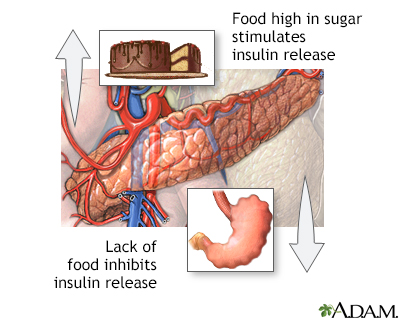Pregnancy SmartSiteTM
DKA; Ketoacidosis; Diabetes - ketoacidosis DefinitionDiabetic ketoacidosis (DKA) is a life-threatening problem that affects people with diabetes. It occurs when the body starts breaking down fat at a rate that is much too fast. The liver processes the fat into a fuel called ketones, which causes the blood to become acidic. CausesDKA happens when the signal from insulin in the body is so low that:
The fat is broken down by the liver into a fuel called ketones. Ketones are normally produced by the liver when the body breaks down fat after it has been a long time since your last meal. These ketones are normally used by the muscles and the heart. When ketones are produced too quickly and build up in the blood, they can be toxic by making the blood acidic. This condition is known as ketoacidosis. DKA is sometimes the first sign of type 1 diabetes in people who have not yet been diagnosed with diabetes. It can also occur in someone who has already been diagnosed with type 1 diabetes. Infection, injury, a serious illness, missing doses of insulin shots, or the stress of surgery can lead to DKA in people with type 1 diabetes. People with type 2 diabetes can develop euglycemic DKA or hyperosmolar hyperglycemic state. It is usually triggered by prolonged uncontrolled blood sugar, missing doses of medicines, as a side effect of some medicines, or a severe illness or infection. SymptomsCommon symptoms of DKA can include:
Exams and TestsKetone testing may be used in type 1 diabetes to check for early ketoacidosis. The ketone test is usually done using a urine sample or a blood sample. Ketone testing is usually done when DKA is suspected:
Other tests for ketoacidosis include:
TreatmentThe goal of treatment is to correct the high blood sugar level with insulin. Another goal is to replace fluids and bodily chemicals lost through urination, loss of appetite, and vomiting if you have these symptoms. If you have diabetes, it is likely your health care provider told you how to spot the warning signs of DKA. If you think you have DKA, test for ketones using urine strips. Some glucose meters can also measure blood ketones. If ketones are present, contact your provider right away. Do not delay. Follow any instructions you are given. It is likely that you will need to go to the hospital. There, you will receive insulin, fluids, and other treatment for DKA. Then providers will also search for and treat the cause of DKA, such as an infection. Outlook (Prognosis)Most people respond to treatment within 24 hours. Sometimes, it takes longer to recover. If DKA is not treated, it can lead to severe illness or death. Possible ComplicationsHealth problems that may result from DKA include any of the following:
When to Contact a Medical ProfessionalDKA is a medical emergency. Contact your provider if you notice symptoms of DKA. Go to the emergency room or call 911 or the local emergency number if you or a family member with diabetes has any of the following:
PreventionIf you have diabetes, learn to recognize the signs and symptoms of DKA. Know when to test for ketones, such as when you are sick. If you use an insulin pump, check often to see that insulin is flowing through the tubing. Make sure the tube is not blocked, kinked or disconnected from the pump. ReferencesAmerican Diabetes Association Professional Practice Committee. 2. Diagnosis and classification of diabetes: standards of care in diabetes-2025. Diabetes Care. 2025;48(Supplement_1):S27-S49. PMID: 39651986 pubmed.ncbi.nlm.nih.gov/39651986/. Gillard P, Atkinson MA, Mathieu C. Type 1 diabetes mellitus. In: Melmed S, Auchus RJ, Goldfine AB, Rosen CJ, Kopp PA, eds. Williams Textbook of Endocrinology. 15th ed. Philadelphia, PA: Elsevier; 2025:chap 35. Maloney GE, Glauser JM. Diabetes mellitus and disorders of glucose homeostasis. In: Walls RM, ed. Rosen's Emergency Medicine: Concepts and Clinical Practice. 10th ed. Philadelphia, PA: Elsevier; 2023:chap 115. | ||
| ||
Review Date: 1/10/2025 Reviewed By: Sandeep K. Dhaliwal, MD, board-certified in Diabetes, Endocrinology, and Metabolism, Springfield, VA. Also reviewed by David C. Dugdale, MD, Medical Director, Brenda Conaway, Editorial Director, and the A.D.A.M. Editorial team. View References The information provided herein should not be used during any medical emergency or for the diagnosis or treatment of any medical condition. A licensed medical professional should be consulted for diagnosis and treatment of any and all medical conditions. Links to other sites are provided for information only -- they do not constitute endorsements of those other sites. No warranty of any kind, either expressed or implied, is made as to the accuracy, reliability, timeliness, or correctness of any translations made by a third-party service of the information provided herein into any other language. © 1997- A.D.A.M., a business unit of Ebix, Inc. Any duplication or distribution of the information contained herein is strictly prohibited. | ||


 Food and insulin r...
Food and insulin r... Insulin pump
Insulin pump
